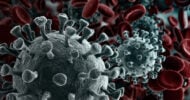Originally published in MedPage Today
by Peggy Peck, MedPage Today Executive Editor
“What we did for patients with acute MI was place them in a cool, dark place. Give them morphine for pain and lidocaine to prevent arrhythmias and hope for the best.”
 The speaker is Steven Nissen, MD, director of Cardiovascular Medicine at the Cleveland Clinic. He is describing standard care 25 years ago when he was a fellow at the University of Kentucky.
The speaker is Steven Nissen, MD, director of Cardiovascular Medicine at the Cleveland Clinic. He is describing standard care 25 years ago when he was a fellow at the University of Kentucky.
“When someone came in with a big infarct — if he survived — we sent him home with a big infarct and waited for more infarcts,” Nissen told MedPage Today.
In the intervening years, the world of cardiology has changed radically and myocardial infarction has gone from a sure killer to a treatable event in which the prognosis is more likely to be survival with little to no disability. Overall, the mortality rate in heart disease has declined by roughly 40%.
“When I cared for patients as an intern and resident from 1982 to 1985, there was very little we could do to limit myocardial injury so most patients experiencing an MI had fairly significant residual left ventricular dysfunction, which put them at risk for heart failure,” said Clyde Yancy, MD, president of the American Heart Association.
“Once heart failure was established, the five-year survival was less than 50%,” Yancy said.
Game-Changing Therapies
A number of landmark events contributed to the decline in cardiovascular mortality associated with MI, but it’s generally agreed that the first of these events was a paper published Dec. 15, 1983 in the New England Journal of Medicine — a small study, with a game-changing finding.
It was a randomized trial that compared the efficacy of intracoronary streptokinase thrombolysis with standard treatment in patients with acute MI. The result was stunning: Coronary reperfusion was achieved in 68% of the 134 streptokinase patients and the 30-day mortality rate was just 3.7% versus 11.2% in the 116-patient control group.
“A threefold reduction in mortality,” Nissen recalled.
But although the impact of this report would be significant, it was far from instantaneous. In 1984, very, very few centers were set up for clot-busting therapy.
And even two years later when Christopher Cannon, MD, of Brigham and Women’s Hospital and Harvard Medical School, was an intern at Columbia University, streptokinase therapy was far from universal.
“Back then there was a night when the residents had a big party and the interns were put in change in the CCU and medical ICU,” Cannon recalled. “I was in charge of the medical ICU when a man came into the emergency department with a massive ST-elevation MI. He was 80-years-old and he had collapsed, dancing at his granddaughter’s wedding.”
The patient “had an infarct as big as you can get and he was in cardiogenic shock.”
Cannon called his resident to ask if streptokinase could be tried. The resident told him that the patient was probably too old for streptokinase — there were no studies of the treatment in patients that old.
As a result, Cannon “simply watched [the patient] die over the next two days.”
That experience was a seminal one for Cannon, who — like Nissen — has made his mark as a researcher treating acute MI.
“Back then, nothing was done to treat the problem of the heart attack, so patients just died of complications of a weakened heart that just couldn’t pump,” Cannon said.
The initial clot-buster — intracoronary streptokinase — was followed by IV streptokinase and finally the introduction of IV tissue plasminogen activator or tPA.
“Use of thrombolysis went from about 10 to 20% in the mid-1980s to about 70% of eligible patients in the late 1980s and it’s been stuck there for a while,” Cannon said.
Beyond thrombolysis for acute treatment, there were other meaningful but seldom heralded advances such as the use of the intra-aortic balloon pump, which allowed doctors to stabilize patients once considered unsuitable for any therapy.
The Dawn of Interventional Cardiology
Major breakthroughs also came in the cath lab as percutaneous coronary interventions came of age.
In 1984, the only PCI option was the “plain vanilla angioplasty balloon” — useful, but almost crude because the rapid expansion of the balloon pressing against the vessel wall often triggered tiny fractures causing plaque to break off and form emboli downstream.
But in the early 1990s, balloons gave way to stents and eventually to drug-eluting stents, or a mixture of bare metal and drug-eluting stents.
It was during this critical period that the value of time emerged.
Stroke neurologists who were making headway with thrombolysis for ischemic stroke hit on the phrase “time is brain” and soon cardiologists had a similar mantra: “time is muscle,” as evidence mounted that faster “door-to-needle” or “door-to-balloon” times meant better outcomes.
Primary PCI became the goal, said Cannon.
As a result “infarct size is way down and often with superfast times [to reperfusion] we can avert a heart attack all together,” Cannon said. “The patient starts with a blocked artery, but we open it so quickly that no heart damage is done.
“This is a wonderful outcome and as we do it more broadly, we found that while the textbooks still said the patient should be in the hospital for a week, we could send them home in a few days. That is the most surprising outcome,” he said.
Wonder Drugs Yield Wondrous Results
On top of the interventions to restore blood flow to the heart, the last 25 years have seen an explosion of cardiovascular drugs that have reduced not only the mortality, but also the morbidity associated with MI.
All of the heart failure drugs came after 1984, Nissen said,
“My father did one of the earliest studies with captopril, the first of the ACE-inhibitors,” Cannon said. The trial studied the drug in the post-MI setting and provided evidence that an ACE-inhibitor could protect the heart and prevent the development of heart failure. Now, Cannon said, “almost everyone with coronary artery disease gets an ACE-inhibitor.”
Patients are also sent home on aspirin, a beta-blocker, and — perhaps most importantly — a statin.
“We didn’t have any statins in 1984. The first one, lovastatin (Mevacor), didn’t come on the market until 1987,” Nissen recalled. “It wasn’t a very good statin, but it was a lot better than what we had before.”
Then simvastatin (Zocor) took off with results of the 4-S trial, which demonstrated that statin therapy reduced the risk of MI, stroke, and death.
“That’s what flipped the switch on cholesterol treatment,” Cannon said.
Surgeons Step Up to the Table
At the same time that cardiovascular drugs and catheter-based therapies were improving, surgery was making giant strides, said Timothy Gardner, MD, a thoracic surgeon and former president of the American Heart Association.
“We have really refined the technique for managing the patient and for dealing with a patient who needed not just bypass but also valve repair or replacement,” Gardner told MedPage Today. “If you look at the [surgical] outcomes you will see lower stroke rates, lower mortality rates at the same time that we are dealing with older, and sometimes sicker patients.”
The major surgical breakthrough came with the discovery that arterial grafts — usually from the left or right interior mammary arteries or the radial artery — were durable.
The “cloud that hung over bypass was the sense that the grafts would only last five years or so,” said Gardner, who is medical director at Christiana Care Center for Heart and Vascular Health in Wilmington, Del. And with saphenous vein grafts five years was often as good as it got, he said.
But first surgeons in Canada and then Floyd D. Loop, MD, and a team of Cleveland Clinic surgeons demonstrated that arterial grafts provided not only a good immediate outcome, but patent arteries for 10 years or longer.
Stroke has always been a risk with heart surgery, but today the stroke rate is “about 1 to 2% overall, but among patients in their 40s or 50s it is even lower,” said Gardner.
Along with the advances in drugs and procedures, came the realization that heart attack patients needed activity, not bed rest.
And that led to the growth of a new cardiology subspecialty — cardiac rehabilitation.
“Fortunately, most cardiac bypass patients qualify for early cardiac rehabilitation and early rehabilitation enhances recovery in many ways,” Gardiner said. For example, he said rehab not only improves physical function, but also reduces the risk of another common comorbidity — depression.
“Rehabilitation reduces the risk of postoperative depression and it speeds recovery,” Gardiner said. “We promote it very strongly because it’s not just about getting over surgery, it’s about getting your life back.”
What’s Next?
A 40% decrease in mortality is no small achievement — Nissen called it “one of the great medical success stories.”
And the list of advances that contributed to that achievement is also impressive, but what, MedPage Today asked, will be the next big thing? The next major advance?
The same answer came back from all our sources — prevention.
Nissen and Cannon are both looking for a breakthrough in agents that raise HDL cholesterol, and Cannon is chairing a 1,600-patient study of an investigative agent that appears to be able to do that by as much as 140%, “which should be a good thing.” But Cannon was cautious in his optimism because the drug is early in development.
Gardner described the future this way, “If we can get our citizens to know how much healthier they can be in terms of simple lifestyle changes — eliminate all smoking, exercise regularly — we can reach our goal of cardiovascular health.”
Finally, Yancy summed up the 25 years saying “We haven’t cured anything but we have certainly changed the natural history. Our efforts over the next 10 years will likely be focused on primary and even primordial prevention, improved quality of care and where myocardial injury has been extensive, we will likely develop regenerative technologies that will once again alter the natural history of heart disease.
“It will be interesting to see how this all plays out.”
Visit MedPageToday.com for more cardiology news.









![Working patients and health care [PODCAST]](https://www.kevinmd.com/wp-content/uploads/Working-patients-and-health-care-190x100.jpg)
![Supporting medical resident families [PODCAST]](https://www.kevinmd.com/wp-content/uploads/Supporting-medical-resident-families-190x100.jpg)


![A tribute to primary care [PODCAST]](https://www.kevinmd.com/wp-content/uploads/A-tribute-to-primary-care-190x100.jpg)
